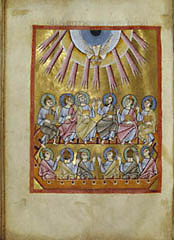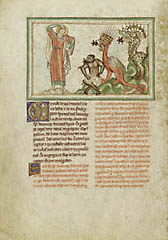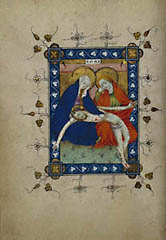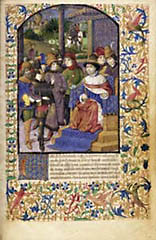| Education | ||
| Exhibitions | ||
| Explore Art | ||
| Research and Conservation | ||
| Bookstore | ||
| Games | ||
| About the J. Paul Getty Museum | ||
| Public Programs | ||
| Museum Home
|
February 11–June 1, 2003 at the Getty Center
From 1000 to 1500 the art of illumination in Europe held a central place in the history of medieval painting, and much of the most beautiful and innovative art of the period appeared in books. The simplicity and abstraction of the Ottonian, the geometric complexities of the Romanesque, and the meticulous observation of the visible world characteristic of the later Middle Ages are among the spectacular developments in illuminated manuscripts that are surveyed in this exhibition.
|
|||||||||||||
This Ottonian benedictional, containing the blessings recited by a bishop at Mass, came from Regensburg, the medieval capital of Bavaria (modern Germany). While on a return trip to his native Bavaria, Bishop Engilmar of Parenzo (modern Porec in northwestern Slovenia) stayed at Saint Emmeram, the most important monastery in medieval Regensburg. The bishop probably turned to the Saint Emmeram monastery for the production of this book. The illuminator's vivid colors, sumptuous gold grounds, and monumental compositions lend a majestic and ceremonial style to these narratives from the New Testament. |
|||||||||||||
This manuscript of the Decretals, a manual of church law, is richly illuminated in a northern French Romanesque style strongly influenced by English art. This type of decoration links the manuscript to a group of books produced for Thomas Becket, Archbishop of Canterbury, and his secretary while they were in exile in France. This page displays the degrees of relationship between a person (the small figure in the central circle) and his or her blood relatives in order to make clear the prohibitions on marriage within one's own family. |
|||||||||||||
Every page of this book contains a brief passage from the Apocalypse written in black ink, a portion of a popular commentary written by a monk named Berengaudus in red ink, and a half-page miniature. The miniatures, executed in a sophisticated tinted drawing technique, faithfully follow Saint John's exceptionally vivid descriptions of the end of time. The illuminator often depicted Saint John looking into the framed scene through a window or door, allowing the reader to vicariously witness the horrific and awesome events unfolding in the Apocalypse. |
|||||||||||||
In the early 1400s in the northern Netherlands, a new dynamic cultural circle developed under the patronage of Albrecht of Bavaria, Count of Holland. A workshop of artists closely associated with the count illuminated this book of hours. These artists, who worked in the International style that so appealed to aristocratic taste across Europe, formed one of the first important illuminator's workshops of 15th-century Holland. With their powerful dramatic style, the eight full-page miniatures in this book provide visual meditations on the sad story of Jesus' Passion, fostering the viewer's empathy for his supreme sacrifice. |
|||||||||||||
This manuscript contains some of the writings of Eneas Silvius Piccolomini, who later reigned as Pope Pius II from 1458-1464. It includes a letter giving advice on how to succeed at court. This miniature, which accompanies the text of the letter, shows a splendidly dressed courtier presenting himself before the French king. Both the ceremony and intrigue of court life are represented here in the subtle gestures of the attendants who whisper and plot with each other. The king himself, however, looks slyly toward us as if to indicate that he is above the fray of these competing factions. |
|||||||||||||






